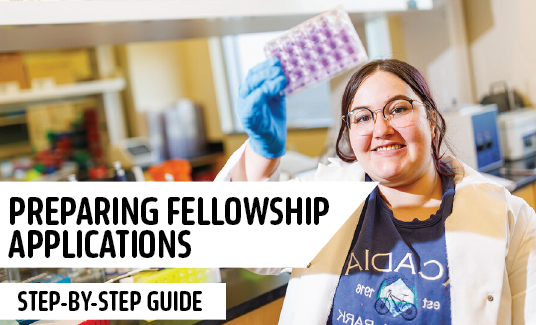
A major fellowship can be a critical funding resource, especially if your research requires money for travel, equipment or supplies, and time to collect data and write. Applying for competitive fellowships takes time, energy, and organization. This article will help you get started. When you consider applying for a fellowship, keep the following in mind:
Many successful applicants begin the process nine months in advance. Major awards are commonly due in mid-to-late fall. Dividing work up in monthly increments will make your work easier.
Applying for competitive fellowships takes time, energy, and organization. Before you begin your application, draft a planning calendar. The calendar provides specific steps and breaks the process into smaller, more manageable parts.
Here’s an example planning calendar to help you successfully complete the application process on time (in this case, for a proposal deadline in November):
February
Key in on an essential research question.
Write down ideas from classes and seminars, lectures you prepare, and papers or articles you read.
Search databases to discover what's already been done in your area of interest — and what hasn't yet been done. Eliminate topics that aren't novel or central to your discipline.
March
Find the right fellowships and gather information.
Explore the sponsor's website to determine eligibility requirements, deadlines, and the number and amount of the awards.
Contact the agency about eligibility if you aren't sure.
Record information on a single spreadsheet for tracking.
April/May
Plan your proposal.
Identify the mission statement for the funding agency. How will your research contribute to the mission?
Carefully review the criteria for each fellowship.
Sponsors define the length and organization of the proposal. Follow directions to the latter! Applications are not considered when they deviate from the requirements.
June/July
Draft the narrative.
State the research question and why the answer is important.
Make a compelling case in the first page (preferably the first paragraph) of the proposal.
Provide enough background to help readers understand the research question, followed by assessing statement of purpose and significance of your research.
Include preliminary results from pilot studies (if there are any).
Show that the methods you propose to use to answer the research question are valid and feasible. Be specific about methodology without being tediously technical.
Demonstrate that your project is manageable within the timeframe of the grant or fellowship.
August/September
Get feedback.
Ask your advisor and their colleagues to read the proposal.
Have colleagues from outside your field make note of undefined terms and jargon.
Make an appointment for a consultation with graduate studies staff.
September/October
Revise.
Use reviewer comments to revise the narrative for clarity of ideas and expression.
Read each section aloud to make sure it flows well.
If you are a non-native English speaker, get an editor.
Have someone with an eye for detail read through your final version.
Review the format and organization requirements for the funding agency, and then read to your proposal once more. Remember many proposals are disqualified simply because they didn't follow the prescribed format or comply with the page limit.
Collect supporting documentation.
Contact potential references well before the application deadline and ask them to write letters of support.
Provide specifics about the fellowship for which you are applying.
Supply a copy of your proposal if they have not already seen a draft.
Suggest what you'd like each recommender to emphasize.
October
Gather collateral and supporting materials.
Remember your entire application counts, not just your research plan.
Don't neglect the other required essays.
The section on your background should justify why you are qualified to carry out the research you propose.
The section on career goals should show how you plan to use the skills you will develop during your schooling.
Update your curriculum vitae.
November
Submit the application.
Submit several days before the deadline to avoid last-minute glitches.
Curious about where to look for opportunities? The University of Nebraska–Lincoln offers several resources to get you started:
The Graduate Studies website hosts a list of external fellowships (financial support provided by federal and privately funded organizations.
The Office of Research and Economic Development posts funding opportunities and you can also subscribe to a listserv for a weekly notice of funding sources. Subscribe one year before you plan on applying for a fellowship.
https://unl.libguides.com/grants is a great resource to start.
Subscribe to the H-Net listserv for your discipline/research areas in the Humanities and Social Sciences.
Learn about international scholarships and fellowships through the International Education Financial Aid website.
Also check the professional organizations for your discipline. Many offers funding for graduate students presenting their research or completing their dissertations.
Sources:
McKinney, Mary (2005). Twelve tips for getting grants. Successful Academic News.
Kiparsky, Michael (2006). Career advice for scientists. The Chronicle of Higher Education
Diffley, Peter & Russo, Joseph (2003). Tips on writing grant and fellowship applications. The Princeton Review.